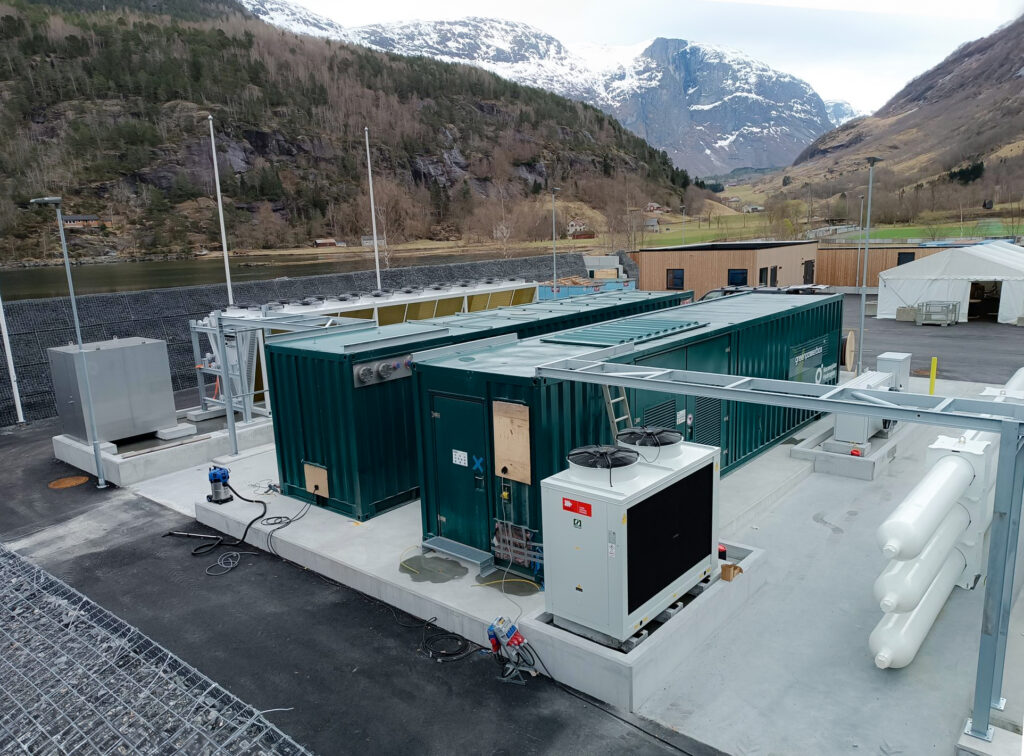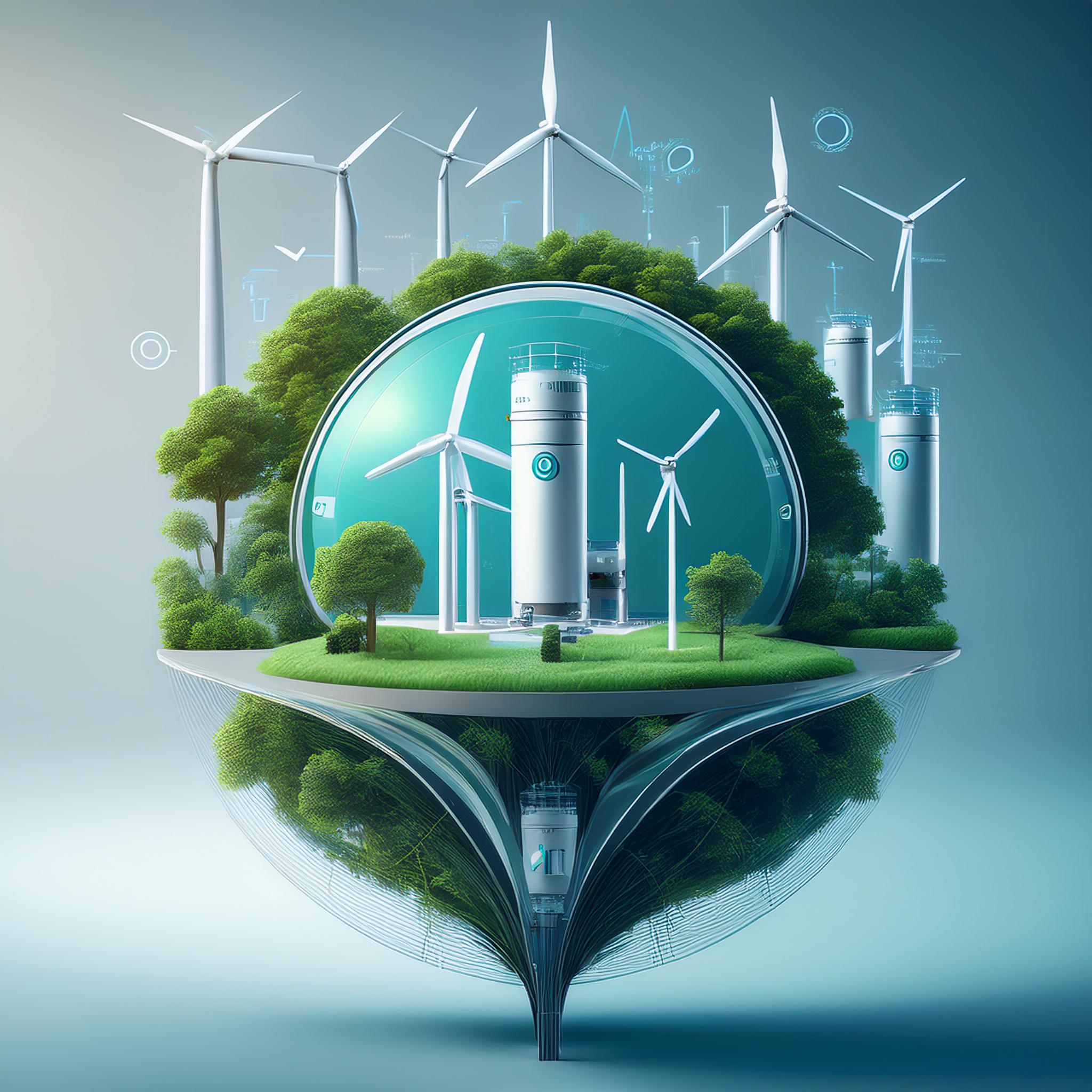Product portfolio
Integrated electrolysis systems for the on-site production of hydrogen
gEL 400/600
Integrated electrolysis systems with 2 MW or 3 MW nominal output.
gEL 1000
Integrated electrolysis systems with a rated output of 5 MW or more.
Energy sources for a green planet
Green hydrogen is hydrogen from renewable energies, which is usually produced by electrolysis of water. No CO 2 emissions are produced during its manufacture. As a storable energy carrier, it enables applications in industry, mobility and energy generation, especially where direct electrification is difficult.
In Germany, the National Hydrogen Strategy envisages an electrolysis capacity of at least ten gigawatts by 2030 in order to meet the growing demand. This page provides a compact guide to the most important basics and practical examples: how green hydrogen is produced and stored, where it is used today and what contribution it makes to the energy transition.
Green energy from renewable sources
Green hydrogen plays a crucial role in the energy transition as it is produced from renewable energy sources, making it a sustainable alternative to fossil fuels. The versatility of green hydrogen enables its use in various sectors, including industry, transportation and power generation.
Power-to-X technologies (PtX) are of particular importance here. The “X” stands for various forms of use, such as gas (power-to-gas), liquid fuels (power-to-liquid), heat (power-to-heat) or chemical base materials (power-to-chemicals). They enable the conversion and storage of surplus energy into green hydrogen.
These hydrogen technologies help to efficiently convert sustainable electricity sources into various forms of energy and make them usable in sectors that are difficult to electrify.


Green hydrogen combines electricity from renewable energy sources with a variety of utilization paths. The term Power to X technologies covers processes that convert electricity into storable and transportable energy sources or raw materials. Fuel cells convert the hydrogen produced back into electricity and heat when required and close the application loop.
Power-to-gas plants convert surplus electricity from renewable energies into hydrogen or synthetic natural gas, which can be stored and used in various sectors. This process helps to stabilize the electricity grids and enables energy to be stored.
Power-to-liquid goes one step further by converting the hydrogen produced into liquid fuels. These can be used in conventional combustion engines, which builds a bridge to the decarbonization of the transport sector.
These use hydrogen to generate electricity by converting chemical energy directly into electrical energy. Such systems can be used in vehicles, buildings and even as large stationary energy sources.
PEM electrolyzers "Made in Germany"
Together we make it successful.
Production - storage - use

Hydrogen electrolysis plants are central facilities for the production, storage, distribution and use of hydrogen. They play a key role in the hydrogen economy and are crucial for the transition to a carbon-free energy supply.
Hydrogen plants can vary greatly depending on their intended use and size, from small decentralized electrolysis plants for self-consumption to large industrial complexes that produce hydrogen on a large scale. Thanks to the use of electricity from renewable sources such as wind or solar power, there are virtually no emissions during the entire production process.
Electrolysis plants are at the heart of the production of green hydrogen. In this process, water (H₂O) is split into its components hydrogen (H₂) and oxygen (O₂). This process requires a considerable amount of electricity, which in the case of green hydrogen comes exclusively from renewable sources. The efficiency of electrolysis is currently around 60-80%.
There are different types of electrolyzers, such as the Proton Exchange Membrane PEM electrolyzer, alkaline electrolysis and high-temperature electrolysis, each of which has its own advantages and disadvantages.
Product portfolio
Integrated electrolysis systems with 2 MW or 3 MW nominal output.
Integrated electrolysis systems with a rated output of 5 MW or more.
gray - blue - green
The various designations such as blue, grey, turquoise, red or green hydrogen do not refer to the color of the gas itself, as hydrogen is naturally colorless. Rather, the colors indicate the respective origin of the hydrogen, the production technology used and the different environmental impacts of hydrogen production.
These colors are the best known:
is produced from fossil fuels such as natural gas, releasing CO2 in the process.
is also produced from fossil fuels, but the CO2 is captured and stored.
on the other hand, is produced by electrolysis using renewable energies and is completely CO2-neutral.

NO | Hellesyslt-Geiranger
Green hydrogen infrastructure from FEST for shipping and tourism in the UNESCO World Heritage Geirangerfjord in Norway

A well-developed hydrogen infrastructure is crucial to enable the widespread use of hydrogen. It includes all the necessary systems and networks to produce, store, transport and deliver hydrogen safely and efficiently to the end consumer.
The storage and transportation of hydrogen is one of the biggest challenges for its widespread use. Hydrogen has a very low energy density per volume, which means that it must be stored either under high pressure (e.g. in pressurized tanks) or at extremely low temperatures (as liquefied hydrogen).
There are also methods for the chemical storage of hydrogen, such as the binding of hydrogen to liquid organic carriers (LOHC) or ammonia, which facilitate transportation.
Fuel cells are one way of recovering the stored energy of hydrogen. They convert hydrogen and oxygen into water, generating electricity that can be used for vehicles or stationary energy sources.
AT | Vienna
FEST develops hydrogen infrastructure for the City of Vienna for the use of green hydrogen in public transportation


Green hydrogen in mobility is a climate-friendly alternative for heavy goods traffic, ships and potentially also air traffic. In energy generation, green hydrogen serves as an energy carrier and storage medium for renewable energy sources and can replace fossil fuels in electricity and heat generation as well as in energy-intensive industrial processes.
Green hydrogen is environmentally friendly, sustainable and can help to reduce dependence on fossil fuels. It offers an emission-free alternative for various applications, from industry and transportation to energy generation.
Element with a history and a future
Hydrogen is the most abundant element in the universe and was first discovered by scientists in the 18th century. The modern development of hydrogen technology began in the 1960s when NASA used hydrogen fuel cells for the Apollo missions. In the following decades, the technologies were further developed, particularly in the field of electrolysis and fuel cells.
Research was intensified by the growing interest in renewable energies and the need to reduce greenhouse gases. The development of electrolyzers has enabled the production of hydrogen without CO₂ emissions, paving the way for green hydrogen. In recent years, there have been significant advances in the efficiency and scalability of these technologies, which are now seen as key to achieving global climate targets.


The use of hydrogen as an energy source is nothing new. Hydrogen has been used in industry, such as in refineries and ammonia production, since the early 20th century. Hydrogen is mainly produced by steam reforming (SMR – Steam Methane Reforming) of fossil natural gas. However, this is associated with considerable CO 2 emissions, as large quantities of carbon dioxide are released during the chemical conversion of the methane.
Despite increasing discussions about decarbonization and the transition to more sustainable energy sources, conventionally produced hydrogen from natural gas remains widely used to this day.
In recent years, there has been increasing pressure to develop technologies for the production of green hydrogen. This involves using electrolysis processes to produce CO 2-free hydrogen using renewable energies.
The future of green hydrogen is closely linked to technological innovations and political decisions. While the challenges are considerable, green hydrogen offers enormous potential that can be exploited both ecologically and economically.
Germany’s National Hydrogen Strategy plays a key role in future energy supply and climate neutrality. The strategy envisages building up an electrolysis capacity of at least ten gigawatts by 2030 in order to meet the growing demand.
Hydrogen is to be used primarily in industry, transportation and for the power supply. It replaces fossil fuels, supports the transition to climate-friendly technologies and will play an important role in the energy transition.
There are different types of hydrogen, depending on the production method (green, gray, blue, brown, etc.). Green hydrogen production through electrolysis with renewable electricity is considered the most climate-friendly option.
Power-to-X technologies convert renewable electricity into storable and transportable energy sources or raw materials, for example hydrogen, synthetic methane or synthetic fuels. They combine electricity generation with applications in industry, mobility and heating and allow reconversion into electricity via fuel cells if required.
It is climate-neutral if the electricity required comes entirely from renewable sources. The decisive factors are guarantees of origin, the operation of the plant and the entire supply chain.
The production of green hydrogen is energy-intensive and is currently not the most efficient method of using renewable energy. Nevertheless, green hydrogen produced using renewable electricity is considered essential for climate neutrality.
Safety is based on zoning according to explosion protection, gas warning and ventilation, clear separation of hydrogen and oxygen and regular testing. HAZOP studies and emergency stop concepts are mandatory components.
The electricity price, plant capacity utilization and efficiency have the greatest influence. Other factors are investment costs, maintenance, location, grid fees and certification.
The national hydrogen strategy promotes investment in hydrogen as an energy source, in particular by expanding the infrastructure. An initial network of over 1,800 kilometers of hydrogen pipelines is to be built in Germany by 2027/28, in addition to a Europe-wide network.
Various ministries support initiatives and real-world laboratories to further develop hydrogen technology and test it in practice. In addition, funding and support measures for projects in developing and emerging countries are important in order to enable the expansion of hydrogen production and the use of such technologies.
Contact us
Pascal Pewinski
Vice President Sales and Business Development
FEST GmbH

You are currently viewing a placeholder content from Vimeo. To access the actual content, click the button below. Please note that doing so will share data with third-party providers.
More InformationYou are currently viewing a placeholder content from YouTube. To access the actual content, click the button below. Please note that doing so will share data with third-party providers.
More InformationYou need to load content from reCAPTCHA to submit the form. Please note that doing so will share data with third-party providers.
More InformationYou are currently viewing a placeholder content from Google Maps. To access the actual content, click the button below. Please note that doing so will share data with third-party providers.
More Information